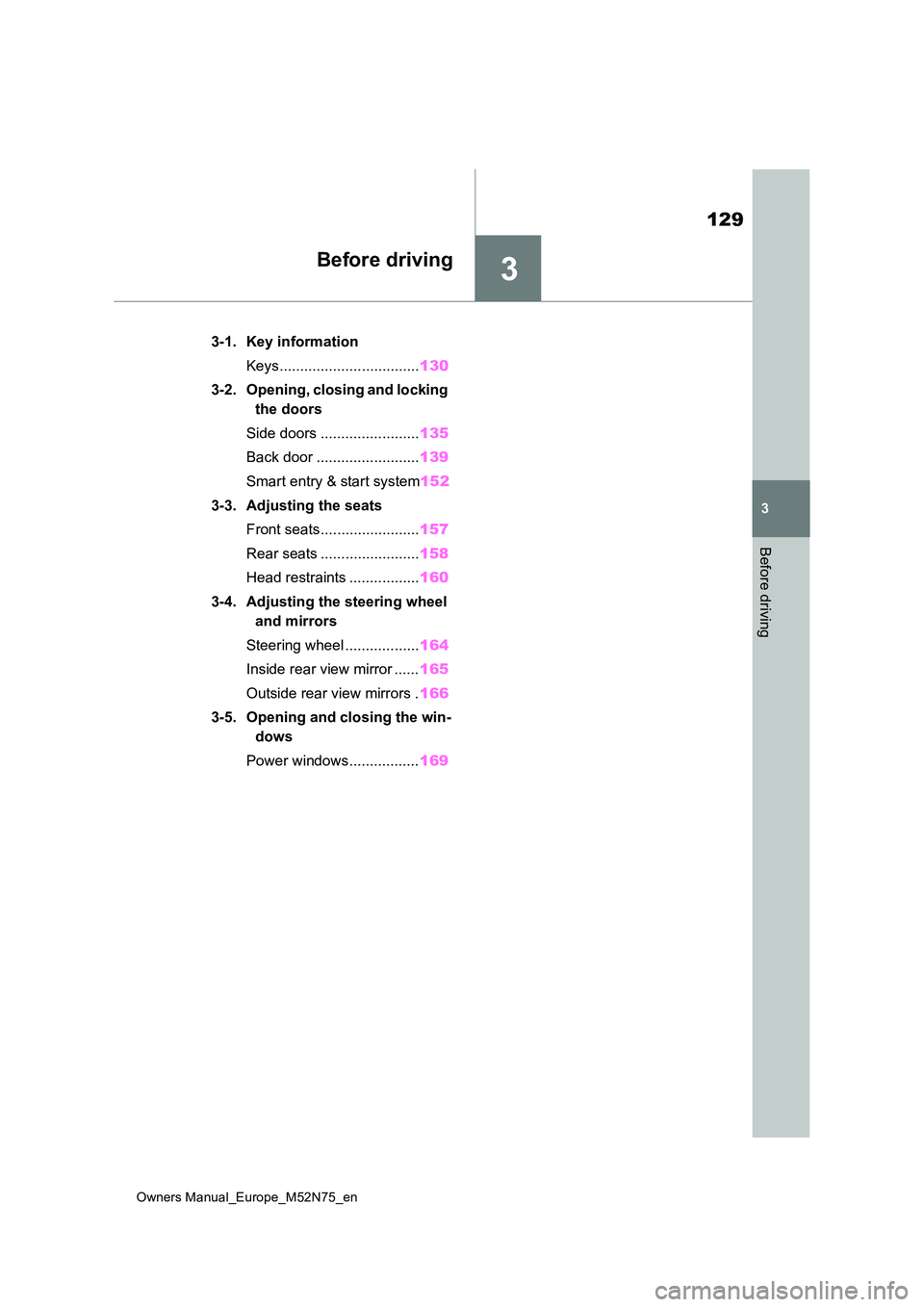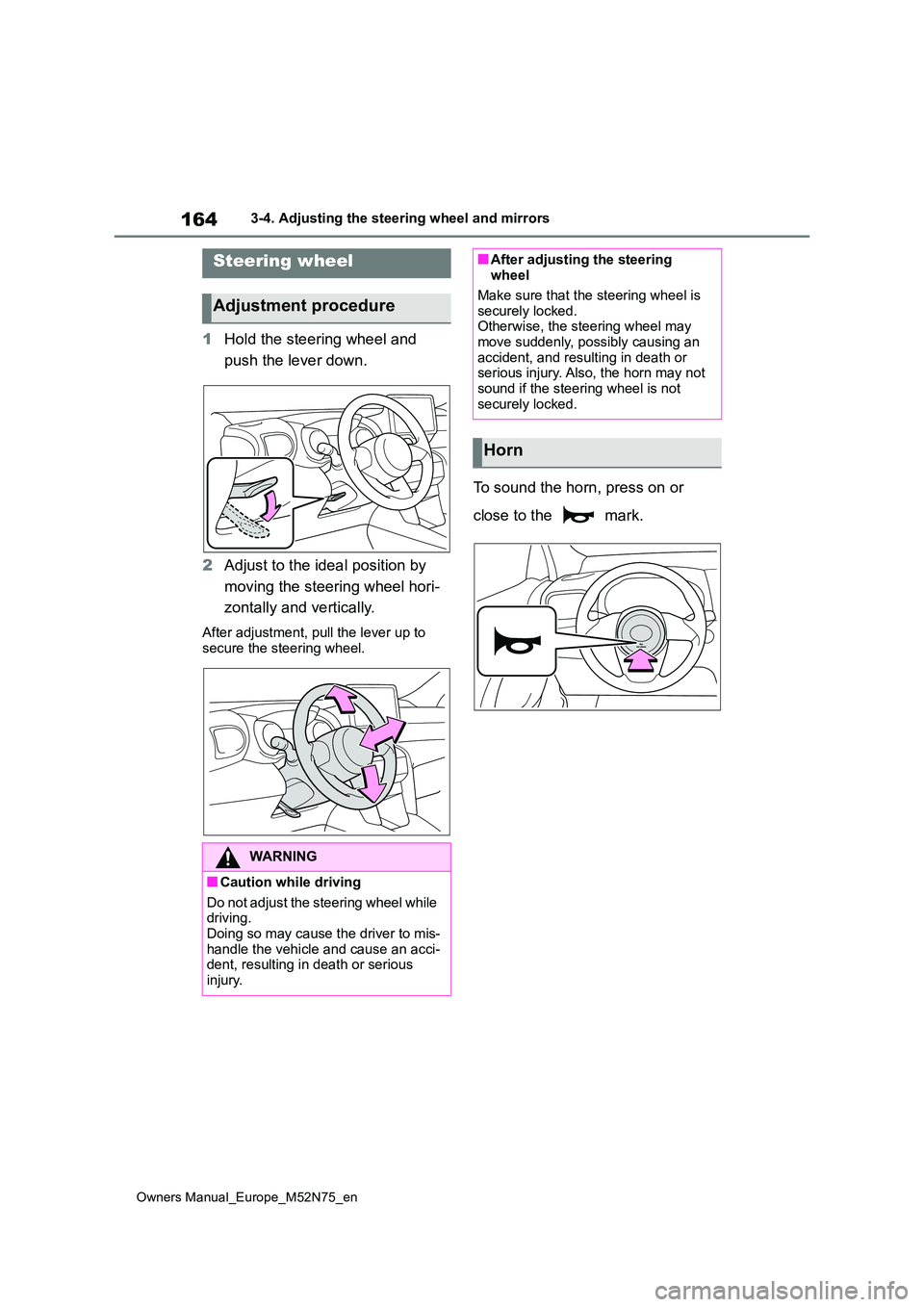2023 TOYOTA YARIS CROSS steering
[x] Cancel search: steeringPage 44 of 698

42
Owners Manual_Europe_M52N75_en
1-1. For safe use
The SRS curtain shield airbags do not
generally inflate if the vehicle is involved in a rear collision, if it rolls over, or if it is involved in a low-speed side or low-
speed frontal collision.
●Collision from the rear
●Vehicle rollover
■When to contact any authorized Toyota retailer or Toyota authorized repairer, or any reliable repairer
In the following cases, the vehicle will require inspection and/or repair. Contact any authorized Toyota retailer or Toyota
authorized repairer, or any reliable repairer as soon as possible.
●Any of the SRS airbags have been inflated.
●The front of the vehicle is damaged or deformed, or was involved in an acci-dent that was not severe enough to
cause the SRS front airbags to inflate.
●A portion of a door or its surrounding
area is damaged, deformed or has
had a hole made in it, or the vehicle was involved in an accident that was not severe enough to cause the SRS
side and curtain shield airbags and SRS front seat center airbags to inflate.
●The pad section of the steering wheel or dashboard near the front passen-
ger airbag is scratched, cracked, or otherwise damaged.
●The surface of the seats with the SRS side airbag and SRS front seat center airbag is scratched, cracked, or other-
wise damaged.
●The portion of the front pillars, rear pil-
lars or roof side rail garnishes (pad- ding) containing the SRS curtain shield airbags inside is scratched,
cracked, or otherwise damaged.
Page 45 of 698

43
1
Owners Manual_Europe_M52N75_en
1-1. For safe use
For safety and security
WARNING
■SRS airbag precautions
Observe the following precautions
regarding the SRS airbags. Failure to do so may cause death or serious injury.
●The driver and all passengers in the vehicle must wear their seat belts
properly. The SRS airbags are supplemental devices to be used with the seat
belts.
●The SRS driver airbag deploys with
considerable force, and can cause death or serious injury especially if the driver is very close to the air-
bag.
Since the risk zone for the driver’s air-
bag is the first 50 - 75 mm (2 - 3 in.) of
inflation, placing yourself 250 mm (10
in.) from your driver airbag provides
you with a clear margin of safety. This
distance is measured from the center
of the steering wheel to your breast-
bone. If you sit less than 250 mm (10
in.) away now, you can change your
driving position in several ways:
• Move your seat to the rear as far as you can while still reaching the ped-als comfortably.
• Slightly recline the back of the seat.Although vehicle designs vary, many drivers can achieve the 250
mm (10 in.) distance, even with the driver seat all the way forward, sim-ply by reclining the back of the seat
somewhat. If reclining the back of your seat makes it hard to see the road, raise yourself by using a firm,
non-slippery cushion, or raise the seat if your vehicle has that feature.
• If your steering wheel is adjustable, tilt it downward. This points the air-bag toward your chest instead of
your head and neck.
The seat should be adjusted as rec-
ommended above, while still main- taining control of the foot pedals, steering wheel, and your view of the
instrument panel controls.
●The SRS front passenger airbag
also deploys with considerable force, and can cause death or seri-ous injury especially if the front pas-
senger is very close to the airbag. The front passenger seat should be as far from the airbag as possible
with the seatback adjusted, so the front passenger sits upright.
●Improperly seated and/or restrained infants and children can be killed or seriously injured by a deploying air-
bag. An infant or child who is too small to use a seat belt should be properly secured using a child
restraint system. Toyota strongly recommends that all infants and children be placed in the rear seats
of the vehicle and properly restrained. The rear seats are safer for infants and children than the
front passenger seat. ( P. 4 9 )
Page 46 of 698

44
Owners Manual_Europe_M52N75_en
1-1. For safe use
WARNING
●Do not sit on the edge of the seat or lean against the dashboard.
●Do not allow a child to stand in front of the SRS front passenger airbag
unit or sit on the knees of a front passenger.
●Do not allow the front seat occu-pants to hold items on their knees.
●Do not lean against the door, the roof side rail or the front, side and rear pillars.
●Do not allow anyone to kneel on the passenger seat toward the door or put their head or hands outside the
vehicle.
●Do not attach anything to or lean
anything against areas such as the dashboard or steering wheel pad.
These items can become projectiles
when the SRS driver and front pas-
senger airbags deploy.
●Do not attach anything to areas such as a door, windshield, side windows, front or rear pillar, roof
side rail and assist grip. (Except for the speed limit label: P.452)
●Do not hang coat hangers or other hard objects on the coat hooks. All of these items could become pro-
jectiles and may cause death or serious injury, should the SRS cur-tain shield airbags deploy.
Page 47 of 698

45
1
Owners Manual_Europe_M52N75_en
1-1. For safe use
For safety and security
WARNING
●Do not use seat accessories which cover the parts where the SRS side
airbags and SRS front seat center airbags inflate as they may interfere with inflation of the SRS airbags.
Such accessories may prevent the SRS side airbags and SRS front seat center airbags from activating
correctly, disable the system or cause the SRS side airbags and SRS front seat center airbags to
inflate accidentally, resulting in death or serious injury.
●Do not strike or apply significant levels of force to the area of the SRS airbag components or the
front doors. Doing so can cause the SRS air-bags to malfunction.
●Do not touch any of the component parts immediately after the SRS air-
bags have deployed (inflated) as they may be hot.
●If breathing becomes difficult after the SRS airbags have deployed, open a door or window to allow
fresh air in, or leave the vehicle if it is safe to do so. Wash off any resi-due as soon as possible to prevent
skin irritation.
●If the areas where the SRS airbags
are stored, such as the steering wheel pad and front and rear pillar garnishes, are damaged or
cracked, have them replaced by any authorized Toyota retailer or Toyota authorized repairer, or any
reliable repairer.
■Modification and disposal of SRS airbag system components
Do not dispose of your vehicle or per-
form any of the following modifica- tions without consulting your Toyota retailer or Toyota authorized repairer,
or any reliable repairer. The SRS air- bags may malfunction or deploy (inflate) accidentally, causing death or
serious injury.
●Installation, removal, disassembly
and repair of the SRS airbags
●Repairs, modifications, removal or
replacement of the steering wheel, instrument panel, dashboard, seats or seat upholstery, front, side and
rear pillars, roof side rails, front door panels, front door trims or front door speakers
●Modifications to the front door panel (such as making a hole in it)
●Repairs or modifications of the front fender, front bumper, or side of the
occupant compartment
●Installation of a grille guard (bull
bars, kangaroo bar, etc.), snow plows or winches
●Modifications to the vehicle’s sus-pension system
●Installation of electronic devices such as mobile two-way radios (RF-transmitter) and CD players
Page 93 of 698

91
2
Owners Manual_Europe_M52N75_en
2-1. Instrument cluster
Vehicle status information and indicators
Vehicles with 7-inch display (when digital speedometer is displayed)
Warning lights inform the driver of
malfunctions in the indicated vehi-
cle’s systems.
Warning lights
(Red)
Brake system warning light*1
( P.435)
(Yellow)
Brake system warning light*1
( P.435)
High coolant temperature
warning light*2 ( P.435)
Hybrid system overheat
warning light*2 ( P.436)
Charging system warning
light*2 ( P.436)
Low engine oil pressure
warning light*2 ( P.436)
Malfunction indicator lamp*1,
3 ( P.436)
SRS warning light*1
( P.437)
ABS warning light*1
( P.437)
Inappropriate pedal opera-
tion warning light*2 ( P. 4 3 7 )
(Red)
Electric power steering sys-
tem warning light*1, 3
( P.438)
(Yellow)
Electric power steering sys-
tem warning light*1, 3
( P.438)
Low fuel level warning light
( P.438)
Driver’s and front passen-
ger’s seat belt reminder light
( P.438)
Rear passengers’ seat
belt reminder lights*2
( P.438)
Tire pressure warning light*1,
3 ( P.439)
(Orange)
LTA i n d i c a t o r*2 (if equipped)
( P.439)
(Flashes)
Toyota parking assist-sensor
OFF indicator*1, 3 (if
equipped) ( P.440)
Page 124 of 698

122
Owners Manual_Europe_M52N75_en
2-1. Instrument cluster
equipped) (P.231)
LTA (Lane Tracing Assist) (if
equipped) ( P.242)
PKSB (Parking Support Brake)
(if equipped) ( P.291)
Brake Override System
( P.176)
Drive-Start Control (P.180)
Details of content displayed on the
head-up display may differ from that
displayed on the multi-information dis-
play. For details, refer to the explana-
tion of each system.
■ icon
Displayed when a warning mes-
sage is displayed on the multi-infor-
mation display. ( P.445)
■Warning message
Some warning messages are dis-
played when necessary, according
to certain conditions.
Details of content displayed on the
head-up display may differ from that
displayed on the multi-information dis-
play.
■Audio system operation status
(if equipped)
Displayed when an audio remote
control switch on the steering wheel
is operated.
■Hands-free system status (if
equipped)
Displayed when the hands-free
system is operated.
■When a pop-up display is displayed
When a pop-up display is displayed, a
current display may no longer be dis- played. In this case, the display will return after the pop-up display disap-
pears.
■Hybrid System Indicator
Charge area
Hybrid Eco area
Eco area
Power area
Displayed content is the same as that
displayed on the multi-information dis-
play (Hybrid System Indicator). For
details, refer to P.96, 102.
■Tachometer
Displays the engine speed in revo-
lutions per minute.
■Outside temperature display
Displayed when the power switch is
turned to ON or when the low out-
side temperature indicator is flash-
ing.
Hybrid System Indica-
tor/Tachometer/Outside tem-
perature display
Page 131 of 698

3
129
Owners Manual_Europe_M52N75_en
3
Before driving
Before driving
3-1. Key information
Keys.................................. 130
3-2. Opening, closing and locking
the doors
Side doors ........................ 135
Back door ......................... 139
Smart entry & start system 152
3-3. Adjusting the seats
Front seats........................ 157
Rear seats ........................ 158
Head restraints ................. 160
3-4. Adjusting the steering wheel
and mirrors
Steering wheel .................. 164
Inside rear view mirror ...... 165
Outside rear view mirrors . 166
3-5. Opening and closing the win-
dows
Power windows................. 169
Page 166 of 698

164
Owners Manual_Europe_M52N75_en
3-4. Adjusting the steering wheel and mirrors
3-4.Adjusting the steering whe el an d mirrors
1Hold the steering wheel and
push the lever down.
2 Adjust to the ideal position by
moving the steering wheel hori-
zontally and vertically.
After adjustment, pull the lever up to
secure the steering wheel.
To sound the horn, press on or
close to the mark.
Steering wheel
Adjustment procedure
WARNING
■Caution while driving
Do not adjust the steering wheel while driving.Doing so may cause the driver to mis-
handle the vehicle and cause an acci- dent, resulting in death or serious injury.
■After adjusting the steering wheel
Make sure that the steering wheel is
securely locked. Otherwise, the steering wheel may move suddenly, possibly causing an
accident, and resulting in death or serious injury. Also, the horn may not sound if the steering wheel is not
securely locked.
Horn